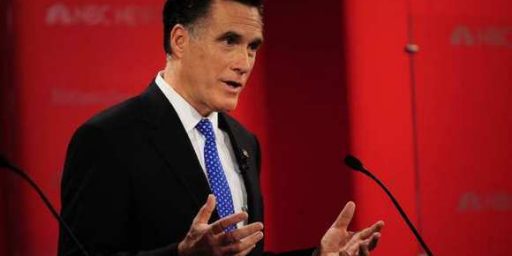The Debate on Taxes Requires Honesty
We need to have a serious debate on taxes and spending. And it would be nice if the debate was honest.
 In a WSJ op/ed, Michael Boskin, who is a professor of Economics at Stanford and chaired the Council of Economic Advisors under the first Bush, warns: Get Ready for a 70% Marginal Tax Rate
In a WSJ op/ed, Michael Boskin, who is a professor of Economics at Stanford and chaired the Council of Economic Advisors under the first Bush, warns: Get Ready for a 70% Marginal Tax Rate
In the piece he makes the following claim:
Some argue the U.S. economy can easily bear higher pre-Reagan tax rates. They point to the 1930s-1950s, when top marginal rates were between 79% and 94%, or the Carter-era 1970s, when the top rate was about 70%. But those rates applied to a much smaller fraction of taxpayers and kicked in at much higher income levels relative to today.
The problem with this claim is twofold:
1) No one of consequences is arguing for a return of top marginal rates to the pre-Reagan era. Indeed, I am not even sure all that many people not of consequence who are making that argument.
2) The degree to which Boskin even makes the claim in the first place is to compare apples (a summing of various taxes) to oranges (one single rate, i.e., the top marginal rates in the pre-Reagan era). This is problematic for a variety of reason, not the least of which being that those who paid those high pre-Reagan top marginal rates also paid other taxes as well. You cannot credibly compare one figure, which is a sum of taxes to one single tax.
To even approximate pre-Reagan taxes Boskin has to both present an incorrect picture of current taxes and make vague predictions about the future.
In terms of the the way Boskin gets his numbers regarding current rates:
Take a teacher in California earning $60,000. A current federal rate of 25%, a 9.5% California rate, and 15.3% payroll tax yield a combined income tax rate of 45%.
This is disingenuous. I would say in error, but Boskin surely knows, given his background, how taxes work. You cannot simply sum rates (his sum, btw, takes into consideration that fact that one can deduct state taxes when calculating federal taxes so instead of 25+9.5+15.3 summing to 49.8% it ends up being adjusted to 45%). Further, the 15.3% payroll tax number is deceiving because that is the combined rate paid by the employer and the employee for payroll taxes. Boskin argues that “While the payroll tax is theoretically split between employers and employees, the employers’ share is ultimately shifted to workers in the form of lower wages.” Even if we stipulate that the existence of payroll taxes leads to diminished wages, one can not turn around and pretend like in addition to that reduction that our teacher friend is also paying the employer’s share of the tax out the gross salary amount. As such, the calculation above is problematic from the get go, but that is just the start of the problems.
First, the 25% federal income tax rate is a marginal rate, i.e., paid only on certain portions of the income in question. Specifically: it does not mean, and Boskin knows this one has to assume given his background, that the teacher in question is not going to be paying 25% of $60,000. If we assume that this teacher’s taxable income (a key concept) is, in fact, $60,000 (which is highly unlikely) and that the teacher is single (or married and filing separately) then the teacher pays (based on current rates) roughly $11,180ish. That is an effective rate of 18.6%.
Second, we should all know that if the teacher’s salary is $60k that that will not be the teacher’s taxable income. If the teacher is married, has kids, has a mortgage, gives to charity, or any number of other things this, too, will reduce the taxable income number used to calculate what is owed, which will ultimately diminish said teacher’s tax burden. Indeed, at a minimum said teacher will at least take the standard deduction, which will lower the taxable income figure.
It is the kind of crude summing alongside treatment of marginal rates as a flat rate on all income, that leads Boskin to assert that we are going to need 70%-80% rates on everyone between 2035-2050. Even if he is right about the cost of the current rate of spending, his general presentation on taxes totally undercuts his argument.
Now, one can argue that taxes are currently too high if one wishes. And, further, one can legitimately be concerned about both the effects of taxation on the economy and the serious problem of entitlement costs on the horizon. But, for goodness’ sake, let’s be honest about this. I have no doubt that people read his column and came away with the idea that teachers in California pay 45% of their income in income and payroll taxes, and this is simply not true. Our tax system is complicated (indeed, far too complicated) but it is possible to discuss tax rates more honestly than picking the top marginal rate and treating like it is the only rate. And, further, we have to be honest about the difference between one’s gross salary figure and one’s taxable income.
On the question of average marginal rates (rather than looking solely at he top marginal rate) over time, I would recommend this post by Bruce Bartlett. In said post he notes:
A typical middle-class family, on the other hand, is paying less in federal taxes than it has since 1967. Its marginal rate is also down substantially since it peaked in 1982 at 31.7 percent. The well-to-do family, too, has seen its average and marginal tax rates decline substantially.
The tables include, by the way, payroll taxes and not just income taxes. State taxes are excluded.






The WSJ has become such a shrill fringe right rag I can’t believe I used to subscribe to it.
I am continually amazed at how many people I know – people who are reasonably intelligent and educated – who do not understand the difference between a marginal rate and overall tax burden.
To do this honestly, we have to look at what the actual real-life tax burden is for various levels of income/wealth. The problem is that is the deductions and other things that impact AGI (such as, for instance, contributing to a 401(k)) make comparisons really hard. You can’t just pick an income level and calculate. You have to set up “a typical middle class family” which involves making a number of assumptions (mortgage? kids? how many? etc).
The complexity of the tax code therefore makes intelligent conversation about tax reform harder (and makes bullshitting about it easier). It sucks.
@Rob in CT:
Indeed.
Some questions for you, Steve… in a perfect world…
What’s your position on corporate taxation? I flirt with coming over to the idea that we should just drop it entirely and rely on income and sales taxes.
How about capital gains? I don’t think treating it differently than other income makes sense. Tax it as normal income, I say. I think this is both a fairness issue (the ‘ole Buffet pays a lower tax rate than his assistant thing) and a potential factor in the ballooning financial sector & its excesses. What say you?
Deductions: I like the idea of getting rid of most if not all of them. What about the deduction for local/state taxes? When I think about it as if it was new policy (as opposed to something I’m used to), it doesn’t sound like a great idea. Isn’t it just subsidizing living in higher-tax areas (such as, you know, Connecticut 🙂 )?
Where do you come down on the FICA payroll tax cap ($106k, IIRC)?
I smell a post coming….
and by the way Steve, thanx for this post, Last week I tried to do a quick calculation of my basic tax burden and gave up after about 15 mins as it was just too complex for this simpleton.
@OzarkHillbilly:
I’ve been meaning to go back through our files and pull out all the tax documentation for 2010 (federal, state, and local property taxes) and tally it up, and then divide by gross income and see what the result is. My guess is about 25%